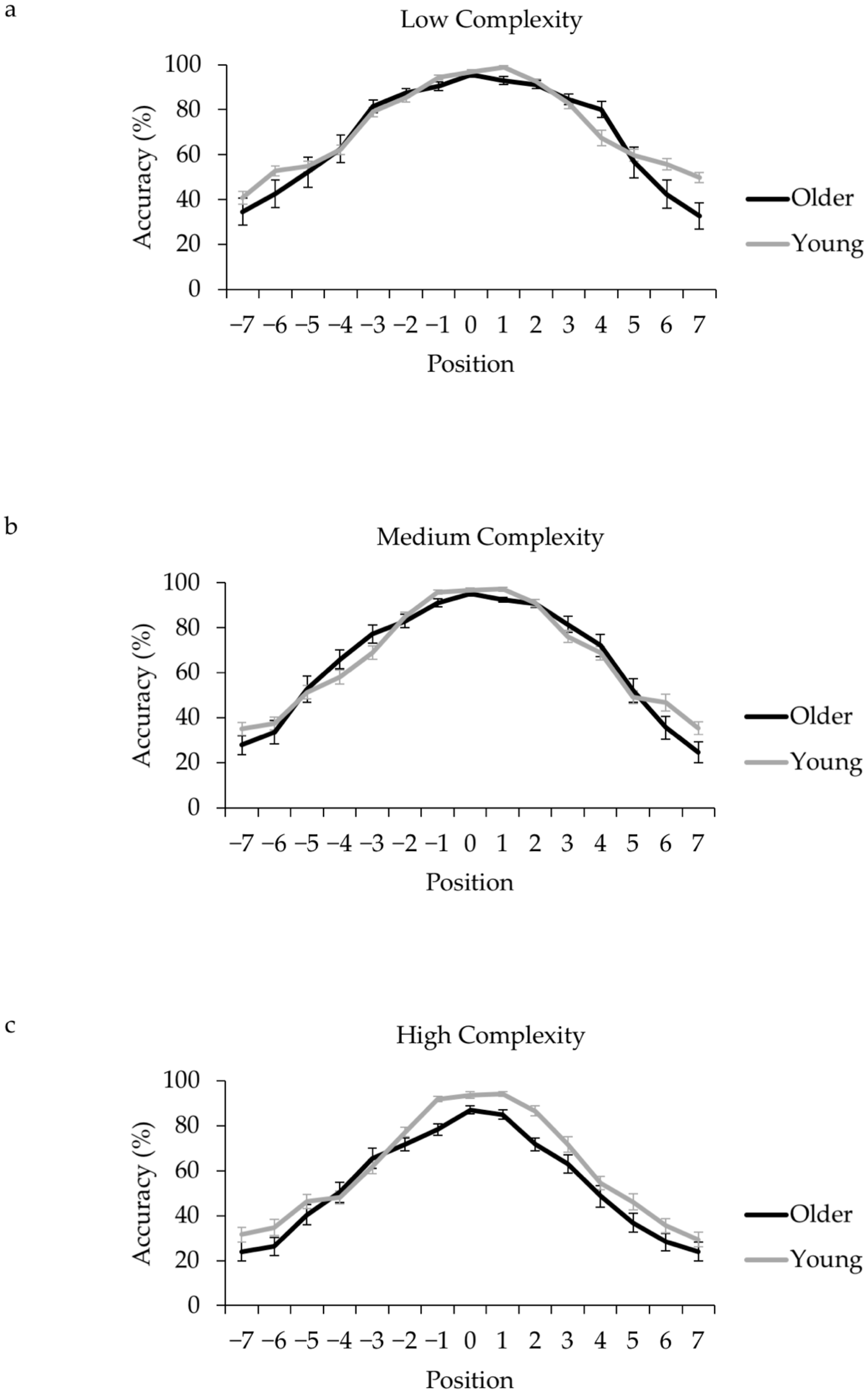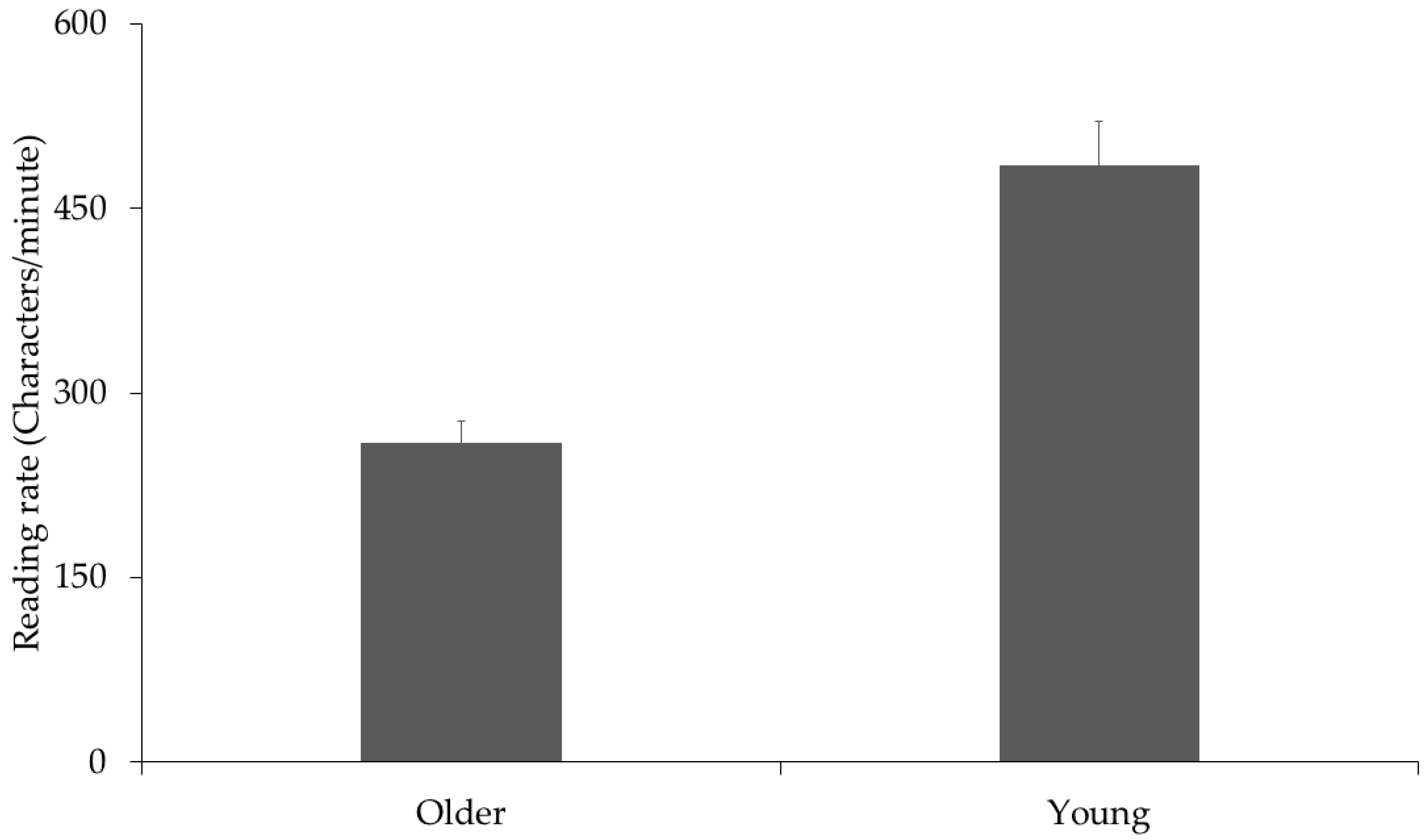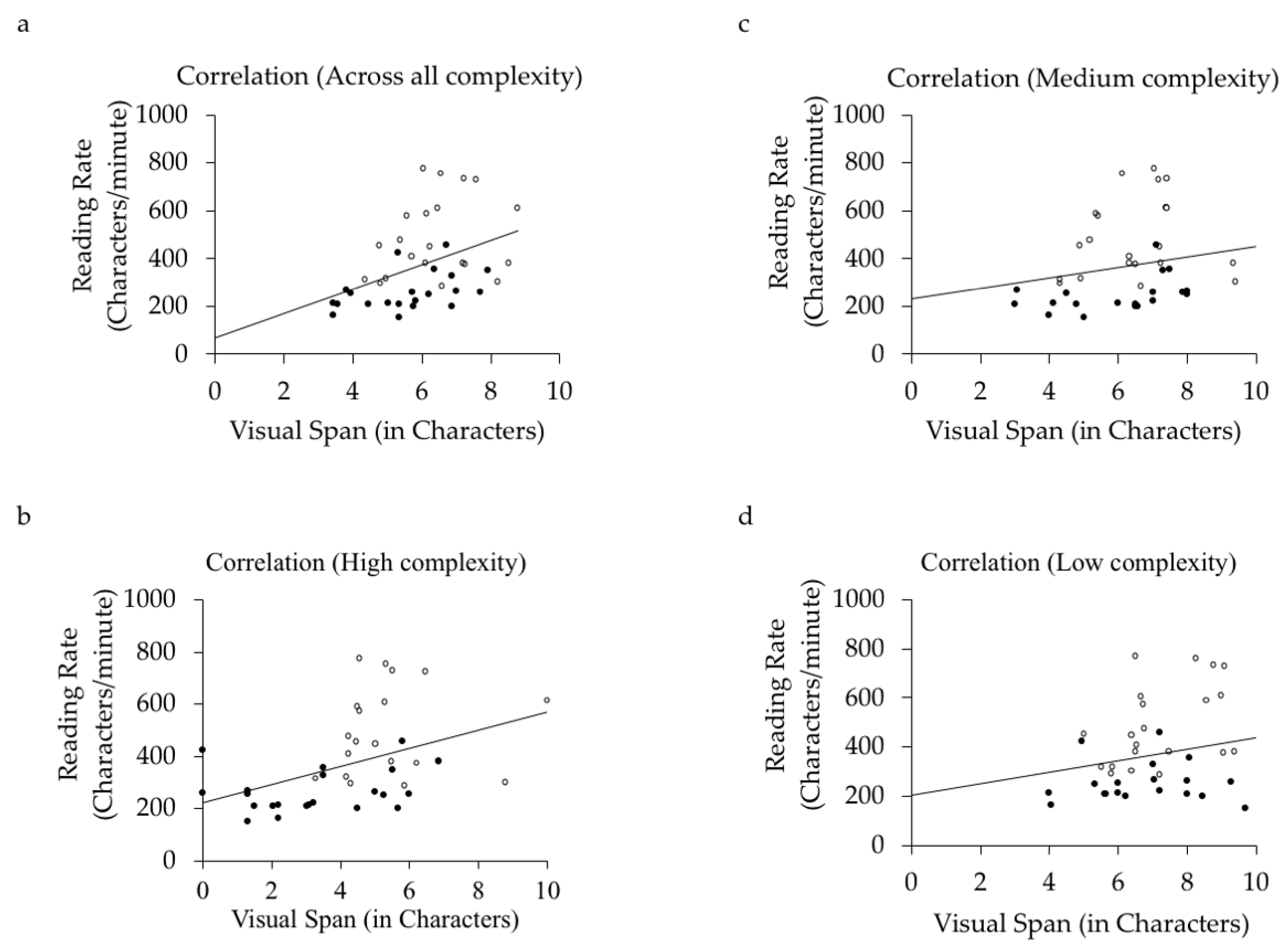Aging and Pattern Complexity Effects on the Visual Span: Evidence from Chinese Character Recognition
Abstract
1. Introduction
2. Materials and Methods
2.1. Participants
2.2. Stimuli and Design
2.3. Apparatus and Procedure
3. Results
3.1. Visual Span Size
3.2. Sentence Reading Speed
4. Discussion
Supplementary Materials
Author Contributions
Funding
Conflicts of Interest
References
- Rayner, K. Eye movements and attention in reading, scene perception, and visual search. Q. J. Exp. Psychol. 2009, 62, 1457–1506. [Google Scholar] [CrossRef] [PubMed]
- Kliegl, R.; Grabner, E.; Rolfs, M.; Engbert, R. Length, frequency, and predictability effects of words on eye movements in reading. Eur. J. Cognit. Psychol. 2004, 16, 262–284. [Google Scholar] [CrossRef]
- McGowan, V.A.; White, S.J.; Jordan, T.R.; Paterson, K.B. Aging and the use of interword spaces during reading: Evidence from eye movements. Psychon. Bull. Rev. 2014, 21, 740–747. [Google Scholar] [CrossRef] [PubMed]
- Paterson, K.B.; McGowan, V.A.; Jordan, T.R. Filtered text reveals adult age differences in reading: Evidence from eye movements. Psychol. Aging 2013, 28, 352–364. [Google Scholar] [CrossRef] [PubMed]
- Paterson, K.B.; McGowan, V.A.; Jordan, T.R. Aging and the control of binocular fixations during reading. Psychol. Aging 2013, 28, 789–795. [Google Scholar] [CrossRef] [PubMed]
- Paterson, K.B.; McGowan, V.A.; Jordan, T.R. Effects of adult aging on reading filtered text: Evidence from eye movements. PeerJ 2013, I, e63. [Google Scholar] [CrossRef]
- Rayner, K.; Reichle, E.D.; Stroud, M.J.; Williams, C.C.; Pollatsek, A. The effect of word frequency, word predictability, and font difficulty on the eye movements of young and older readers. Psychol. Aging 2006, 21, 448–465. [Google Scholar] [CrossRef]
- Rayner, K.; Castelhano, M.S.; Yang, J. Eye movements and the perceptual span in older and younger readers. Psychol. Aging 2009, 24, 755–760. [Google Scholar] [CrossRef] [PubMed]
- Rayner, K.; Yang, J.; Schuett, S.; Slattery, T.J. The effect of foveal and parafoveal masks on the eye movements of older and younger readers. Psychol. Aging 2014, 29, 205–212. [Google Scholar] [CrossRef]
- Stine-Morrow, E.A.; Shake, M.C.; Miles, J.R.; Lee, K.; Gao, X.; McConkie, G. Pay now or pay later: Aging and the role of boundary salience in self-regulation of conceptual integration in sentence processing. Psychol. Aging 2010, 25, 168–176. [Google Scholar] [CrossRef]
- Warrington, K.L.; McGowan, V.A.; Paterson, K.B.; White, S.J. Effects of aging, word frequency and text stimulus quality on reading across the adult lifespan: Evidence from eye movements. J. Exp. Psychol. Learn. Mem. Cognit. 2018, 44, 1714–1729. [Google Scholar] [CrossRef]
- Warrington, K.; White, S.J.; Paterson, K.B. Ageing and the misperception of words: Evidence from eye movements during reading. Q. J. Exp. Psychol. 2018, 71, 75–80. [Google Scholar] [CrossRef]
- Whitford, V.; Titone, D. Eye movements and the perceptual span during first-and second-language sentence reading in bilingual older adults. Psychol. Aging 2016, 31, 58–70. [Google Scholar] [CrossRef]
- Whitford, V.; Titone, D. The effects of word frequency and word predictability during first-and second-language paragraph reading in bilingual older and younger adults. Psychol. Aging 2017, 32, 158–177. [Google Scholar] [CrossRef]
- Li, S.; Li, L.; Wang, J.; McGowan, V.A.; Paterson, K.B. Effects of word length on eye guidance differ for young and older Chinese readers. Psychol. Aging 2018, 33, 685–692. [Google Scholar] [CrossRef]
- Wang, J.; Li, L.; Li, S.; Xie, F.; Chang, M.; Paterson, K.B.; McGowan, V.A. Adult age differences in eye movements during reading: The evidence from Chinese. J. Gerontol. Ser. B 2018, 73, 584–593. [Google Scholar] [CrossRef]
- Wang, J.; Li, L.; Li, S.; Xie, F.; Liversedge, S.P.; Paterson, K.B. Effects of aging and text-stimulus quality on the word-frequency effect during Chinese reading. Psychol. Aging 2018, 33, 693–712. [Google Scholar] [CrossRef]
- Zang, C.; Zhang, M.; Bai, X.; Yan, G.; Paterson, K.B.; Liversedge, S.P. Effects of word frequency and visual complexity on eye movements of young and older Chinese readers. Q. J. Exp. Psychol. 2016, 69, 1409–1425. [Google Scholar] [CrossRef]
- Risse, S.; Kliegl, R. Adult age differences in the perceptual span during reading. Psychol. Aging 2011, 26, 451–460. [Google Scholar] [CrossRef]
- Ball, K.K.; Beard, B.L.; Roenker, D.L.; Miller, R.L.; Griggs, D.S. Age and visual search: Expanding the useful field of view. J. Opt. Soc. Am. A 1988, 5, 2210–2219. [Google Scholar] [CrossRef]
- Crassini, B.; Brown, B.; Bowman, K. Age-related changes in contrast sensitivity in central and peripheral retina. Perception 1988, 17, 315–332. [Google Scholar] [CrossRef]
- Sekuler, B.; Bennett, P.J.; Mamelak, M. Effects of aging on the useful field of view. Exp. Aging Res. 2000, 26, 103–120. [Google Scholar] [CrossRef]
- Elliott, D.B.; Yang, K.C.; Whitaker, D. Visual acuity changes throughout adulthood in normal, healthy eyes: Seeing beyond 6/6. Optom. Vis. Sci. 1995, 72, 186–191. [Google Scholar] [CrossRef]
- Owsley, C.; Sekuler, R.; Siemsen, D. Contrast sensitivity throughout adulthood. Vis. Res. 1983, 23, 689–699. [Google Scholar] [CrossRef]
- Owsley, C. Aging and vision. Vis. Res. 2011, 51, 1610–1622. [Google Scholar] [CrossRef]
- McConkie, G.W.; Rayner, K. The span of the effective stimulus during a fixation in reading. Percept. Psychophys. 1975, 17, 578–586. [Google Scholar] [CrossRef]
- Rayner, K. The gaze-contingent moving window in reading: Development and review. Vis. Cognit. 2014, 22, 242–258. [Google Scholar] [CrossRef]
- Inhoff, A.W.; Pollatsek, A.; Posner, M.I.; Rayner, K. Covert attention and eye movements during reading. Q. J. Exp. Psychol. 1989, 41A, 63–89. [Google Scholar] [CrossRef]
- Rayner, K. Eye movements and the perceptual span in beginning and skilled readers. J. Exp. Child Psychol. 1986, 41, 211–236. [Google Scholar] [CrossRef]
- Rayner, K.; McConkie, G.W.; Ehrlich, S. Eye movements and integrating information across fixations. J. Exp. Psychol. Hum. Percept. Perform. 1978, 4, 529–544. [Google Scholar] [CrossRef]
- Frey, A.; Bosse, M.L. Perceptual span, visual span, and visual attention span: Three potential ways to quantify limits on visual processing during reading. Vis. Cognit. 2018, 26, 412–429. [Google Scholar] [CrossRef]
- Henderson, J.M.; Ferreira, F. Effects of foveal processing difficulty on the perceptual span in reading: Implications for attention and eye movement control. J. Exp. Psychol. Learn. Mem. Cognit. 1990, 16, 417–429. [Google Scholar] [CrossRef]
- Kennison, S.M.; Clifton, C. Determinants of parafoveal preview benefit in high and low working memory capacity readers: Implications for eye movement control. J. Exp. Psychol. Learn. Mem. Cognit. 1995, 21, 68–81. [Google Scholar] [CrossRef]
- He, Y.; Legge, G.E. Linking crowding, visual span, and reading. J. Vis. 2017, 17, 1–15. [Google Scholar] [CrossRef]
- Legge, G.E.; Ahn, S.J.; Klitz, T.S.; Luebker, A. Psychophysics of reading—XVI. The visual span in normal and low vision. Vis. Res. 1997, 37, 1999–2010. [Google Scholar] [CrossRef]
- Legge, G.E.; Cheung, S.H.; Yu, D.; Chung, S.T.; Lee, H.W.; Owens, D.P. The case for the visual span as a sensory bottleneck in reading. J. Vis. 2007, 7, 1–15. [Google Scholar] [CrossRef]
- Legge, G.E.; Mansfield, J.S.; Chung, S.T. Psychophysics of reading: XX. Linking letter recognition to reading speed in central and peripheral vision. Vis. Res. 2001, 41, 725–743. [Google Scholar] [CrossRef]
- O’Regan, J.K. Eye movements and reading. Rev. Oculomot. Res. 1990, 4, 395–453. [Google Scholar]
- Yu, D.; Cheung, S.H.; Legge, G.E.; Chung, S.T. Effects of letter spacing on visual span and reading speed. J. Vis. 2007, 7, 1–10. [Google Scholar] [CrossRef]
- Bouma, H. Interaction effects in parafoveal letter recognition. Nature 1970, 226, 177–178. [Google Scholar] [CrossRef]
- Levi, D.M. Visual crowding. Curr. Biol. 2011, 21, 678–679. [Google Scholar] [CrossRef]
- Whitney, D.; Levi, D.M. Visual crowding: A fundamental limit on conscious perception and object recognition. Trends Cognit. Sci. 2011, 15, 160–168. [Google Scholar] [CrossRef]
- Grainger, J.; Dufau, S.; Ziegler, J.C. A vision of reading. Trends Cognit. Sci. 2016, 20, 171–179. [Google Scholar] [CrossRef]
- Luck, S.J.; Vogel, E.K. The capacity of visual working memory for features and conjunctions. Nature 1997, 390, 279–281. [Google Scholar] [CrossRef]
- Bundesen, C. A theory of visual attention. Psychol. Rev. 1990, 97, 523–547. [Google Scholar] [CrossRef]
- Liu, R.; Patel, B.N.; Kwon, M. Age-related changes in crowding and reading speed. Sci. Rep. 2017, 7, 8271. [Google Scholar] [CrossRef]
- Kwon, M.; Legge, G.E.; Dubbels, B.R. Developmental changes in the visual span for reading. Vis. Res. 2007, 47, 2889–2900. [Google Scholar] [CrossRef]
- Cheong, A.M.Y.; Legge, G.E.; Lawrence, M.; Cheung, S.-H.; Ruff, M. Relationship between visual span and reading performance in age-related macular degeneration. Vis. Res. 2008, 48, 577–588. [Google Scholar] [CrossRef]
- Wang, H.; He, X.; Legge, G.E. Effect of pattern complexity on the visual span for Chinese and alphabet characters. J. Vis. 2014, 14, 1–17. [Google Scholar] [CrossRef]
- Scialfa, C.T.; Cordazzo, S.; Bubric, K.; Lyon, J. Aging and visual crowding. J. Gerontol. Ser. B 2013, 68, 522–528. [Google Scholar] [CrossRef]
- Jordan, T.R.; Patching, G.R.; Milner, A.D. Central fixations are inadequately controlled by instructions alone: Implications for studying cerebral asymmetry. Q. J. Exp. Psychol. 1998, 51A, 371–391. [Google Scholar] [CrossRef]
- Jordan, T.R.; Patching, G.R.; Milner, A.D. Lateralized word recognition: Assessing the role of hemispheric specialization, modes of lexical access and perceptual asymmetry. J. Exp. Psychol. Hum. Percept. Perform. 2000, 26, 1192–1208. [Google Scholar] [CrossRef]
- Jordan, T.R.; Paterson, K.B. Re-evaluating split-fovea processing in word recognition: A critical assessment of recent research. Neuropsychologia 2009, 47, 2341–2353. [Google Scholar] [CrossRef]
- Jordan, T.R.; Paterson, K.B.; Kurtev, S.; Xu, M. Do fixation cues ensure fixation accuracy in split-fovea studies of word recognition? Neuropsychologia 2009, 47, 2004–2007. [Google Scholar] [CrossRef]
- Kosnik, W.; Kline, D.; Fikre, J.; Sekuler, R. Ocular fixation control as a function of age and exposure duration. Psychol. Aging 1987, 2, 302–305. [Google Scholar] [CrossRef]
- Taylor, H.R. Applying new design principles to the construction of an illiterate E chart. Am. J. Optom. Physiol. Opt. 1978, 55, 348–351. [Google Scholar] [CrossRef]
- Nasreddine, Z.S.; Phillips, N.A.; Bédirian, V.; Charbonneau, S.; Whitehead, V.; Collin, I.; Cummings, J.L.; Chertkow, H. The Montreal Cognitive Assessment, MoCA: A brief screening tool for mild cognitive impairment. J. Am. Geriatr. Soc. 2005, 53, 695–699. [Google Scholar] [CrossRef]
- State Language Work Committee, Bureau of Standard. Modern Chinese Character Frequency Table; Beijing Language Press: Beijing, China, 1992. [Google Scholar]
- State Key Laboratory of Intelligent Technology and Systems. Tsinghua University, & Institute of Automation, Chinese Academy of Sciences 2003. Available online: http://www.lits.tsinghua.edu.cn/ainlp/source.htm (accessed on 19 March 2019).
- Zhang, J.Y.; Zhang, T.; Xue, F.; Liu, L.; Yu, C. Legibility of Chinese characters in peripheral vision and the top-down influences on crowding. Vis. Res. 2009, 49, 44–53. [Google Scholar] [CrossRef]
- Han, T.; Kobayashi, K. Mathematics of Information and Coding; American Mathematical Society: Providence, RI, USA, 2002; Volume 203. [Google Scholar]
- Inhoff, A.W.; Liu, W. The perceptual span and oculomotor activity during the reading of Chinese sentences. J. Exp. Psychol. Hum. Percept. Perform. 1998, 24, 20–34. [Google Scholar] [CrossRef]
- Yan, M.; Zhou, W.; Shu, H.; Kliegl, R. Perceptual span depends on font size during the reading of Chinese sentences. J. Exp. Psychol. Learn. Mem. Cognit. 2015, 41, 209–219. [Google Scholar] [CrossRef]
- He, Y.; Legge, G.E.; Yu, D. Sensory and cognitive influences on the training-related improvement of reading speed in peripheral vision. J. Vis. 2013, 13, 1–14. [Google Scholar] [CrossRef]
- Coates, D.R.; Levi, D.M.; Touch, P.; Sabeson, R. Foveal crowding resolved. Sci. Rep. 2018, 8, 9177. [Google Scholar] [CrossRef] [PubMed]
- Lev, M.; Yehezkel, O.; Polat, U. Uncovering foveal crowding? Sci. Rep. 2014, 4, 4067. [Google Scholar] [CrossRef] [PubMed]
- Yehezkel, O.; Sterkin, A.; Lev, M.; Polat, U. Crowding is proportional to visual acuity in young and aging eyes. J. Vis. 2015, 15, 23. [Google Scholar] [CrossRef] [PubMed][Green Version]
- Li, X.; Bicknell, K.; Liu, P.; Wei, W.; Rayner, K. Reading is fundamentally similar across disparate writing systems: A systematic characterization of how words and characters influence eye movements in Chinese reading. J. Exp. Psychol. Gen. 2014, 143, 895–913. [Google Scholar] [CrossRef]
- Liversedge, S.P.; Zang, C.; Zhang, M.; Bai, X.; Yan, G.; Drieghe, D. The effect of visual complexity and word frequency on eye movements during Chinese reading. Vis. Cognit. 2014, 22, 441–457. [Google Scholar] [CrossRef]
- Ma, G.; Li, X. How character complexity modulates eye movement control in Chinese reading. Read. Writ. 2015, 28, 747–761. [Google Scholar] [CrossRef]
- Yang, H.M.; McConkie, G.W. Reading Chinese: Some basic eye-movement characteristics. In Reading Chinese Script: A Cognitive Analysis; Wang, Y., Inhoff, A.W., Chen, H.-C., Eds.; Erlbaum: Mahwah, NJ, USA, 1999; pp. 207–222. [Google Scholar]




| Adult Age Group | High Complexity | Medium Complexity | Low Complexity | |
|---|---|---|---|---|
| Characters (best-fitting curves) | Older | 3.1 (0.4) | 6.4 (0.5) | 7.1 (0.5) |
| Young | 5.5 (0.4) | 6.5 (0.3) | 7.2 (0.3) | |
| Characters (single-Gaussian curves) | Older | 3.7 (0.6) | 6.8 (0.5) | 7.6 (0.6) |
| Young | 5.5 (0.4) | 6.5 (0.3) | 7.2 (0.3) | |
| Bits | Older | 52 (2.1) | 58 (2.0) | 61 (1.5) |
| Young | 57 (1.1) | 60 (0.7) | 62 (0.5) |
| Age Group | Character Complexity | Age Group*Character Complexity | ||||||||
|---|---|---|---|---|---|---|---|---|---|---|
| df | F | p | ηp2 | F | p | ηp2 | F | p | ηp2 | |
| Visual Span (best-fitting curves) | 2, 80 | 3.91 | 0.06 | 0.09 | 41.26 | <0.001 | 0.51 | 8.42 | <0.001 | 0.17 |
| Visual Span (single-Gaussian curves) | 1.63, 64.59 | 1.14 | 0.29 | 0.03 | 42.43 | <0.001 | 0.51 | 5.89 | <0.01 | 0.13 |
| Character Complexity | t | df | p | Cohen’s d |
|---|---|---|---|---|
| Low | 0.20 | 40 | 0.84 | 0.07 |
| Medium | 0.09 | 40 | 0.93 | 0.03 |
| High | 4.40 | 40 | <0.001 | 1.36 |
© 2019 by the authors. Licensee MDPI, Basel, Switzerland. This article is an open access article distributed under the terms and conditions of the Creative Commons Attribution (CC BY) license (http://creativecommons.org/licenses/by/4.0/).
Share and Cite
Xie, F.; Li, L.; Zhao, S.; Wang, J.; Paterson, K.B.; White, S.J.; Warrington, K.L. Aging and Pattern Complexity Effects on the Visual Span: Evidence from Chinese Character Recognition. Vision 2019, 3, 11. https://doi.org/10.3390/vision3010011
Xie F, Li L, Zhao S, Wang J, Paterson KB, White SJ, Warrington KL. Aging and Pattern Complexity Effects on the Visual Span: Evidence from Chinese Character Recognition. Vision. 2019; 3(1):11. https://doi.org/10.3390/vision3010011
Chicago/Turabian StyleXie, Fang, Lin Li, Sainan Zhao, Jingxin Wang, Kevin B. Paterson, Sarah J. White, and Kayleigh L. Warrington. 2019. "Aging and Pattern Complexity Effects on the Visual Span: Evidence from Chinese Character Recognition" Vision 3, no. 1: 11. https://doi.org/10.3390/vision3010011
APA StyleXie, F., Li, L., Zhao, S., Wang, J., Paterson, K. B., White, S. J., & Warrington, K. L. (2019). Aging and Pattern Complexity Effects on the Visual Span: Evidence from Chinese Character Recognition. Vision, 3(1), 11. https://doi.org/10.3390/vision3010011





